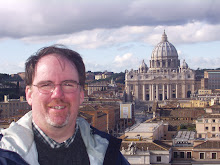
A little over one month ago, the St. John's College Seminary hosted their annual "Godfrey Diekmann, OSB Lecture" on the images of God in the new translation of the Roman Missal.
The major presentation was given by Msgr. Bruce Harbert, Executive Director of the International Commission for English in the Liturgy (ICEL) and the mover and shaker behind much of the new translation. A response was given by Rev. Dr. Carl P. Daw, Jr., best known to many for his wonderful hymn texts and as Executive Director of the Hymn Society. Both talks are available online. Both talks are worth reading.
Msgr. Harbert spoke in detail about the philosophies of the new translation, citing many specific instances. "Retranslating the Missal," he said, "is like cleaning the Sistine Chapel: the work enables us to see riches that have been previously hidden." Examples discussed (the translations of digneris, dignatus, benignus, pius, pietas, etc.) were well-documented and showed a desire to ensure an appropriate attitude toward God--one which acknowledges him as Creator and us as Created; one which confirms his consistent justice and mercy and our need for that mercy.
In general, there is an attempt to "elevate" the language. "Those who claim that the liturgy should follow the patterns of ordinary speech," Harbert said, "overlook the existence of a silent consensus that liturgical language should have a degree of formality."
Rev. Daw's response addressed many of these points. He spoke of the roots of the English language and the influence other languages have had on our own. He expressed concern regarding some conflicting points in Liturgiam Authenticam (the document governing the translation) and addresses inconsistencies in the way some phrases are translated. The issues he cites are not simply nit-picking the work of another. He addresses underlying theological concerns in a very thoughtful matter. In conclusion, he says,
I can fully appreciate the impulse to lend dignity to the language of the liturgy, but I am concerned about the attendant implication that God works only in situations removed from ordinary existence. It seems to me that the language of the liturgy ought to avail itself of every opportunity to affirm that God can make the common holy, can redeem that which seems least promising, can turn persecutors into proclaimers, can transform what seems worthless into something beyond price.
As I stated earlier, these presentations are both interesting and insightful. They show that translation is not a science. Often many words are available and the translator must sort through appropriate words and, ultimately, translate them as best he or she can within the guiding philosophy. However, when all is said and done, regardless of one's praises or critiques of these translations, we will have a Roman Missal that some will love and some will hate--but we all must use! And this prayer is the prayer that expresses and forms our unity as the Body of Christ!
 On a final note, the namesake of this lecture, Fr. Godfrey Diekmann, OSB (1908-2002), is a prominent name in the liturgical movement. He was one of a handful of scholars who assisted in preparing liturgical material for the Second Vatican Council and he taught for decades at St. John's in Collegeville. His unswerving confidence in the aims of the reform were infectious.
On a final note, the namesake of this lecture, Fr. Godfrey Diekmann, OSB (1908-2002), is a prominent name in the liturgical movement. He was one of a handful of scholars who assisted in preparing liturgical material for the Second Vatican Council and he taught for decades at St. John's in Collegeville. His unswerving confidence in the aims of the reform were infectious.Fr. Diekmann taught many of my friends and colleagues. I met him (briefly) about ten years ago when I was attending a meeting in Collegeville with other directors of Offices of Worship from the Midwest. I still recall that he waited outside the chapel for us one day after Morning Prayer enthusiastically greeting us and encouraging us to keep working! I was so very impressed that this brilliant and influential man was humble enough that he'd wait around just to say hello to a bunch of diocesan employees! He, like Christ whom he tried to imitate, was greatest because he made himself least of all.

No comments:
Post a Comment